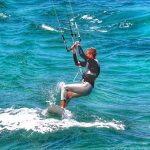If you’re new to kiteboarding, you’ll need to learn how to trim your kite. This is an important skill that will help you enjoy the sport more. Trimming your kite means adjusting the tension on the control bar so that the kite flies the way you want it to.
It’s not difficult to learn, but it takes a bit of practice to get the hang of it.
If your kite isn’t trimmed correctly, you may have a hard time staying afloat, which is something you don’t want when you’re trying to catch some waves!
If you follow the simple steps laid out in this article, you’ll be kiteboarding in no time!
What is Kiteboarding Trimming?
To optimize the performance of your kite, you need to adjust its settings. This is called kiteboarding trimming. Depending on what type of kiteboarder you are and what conditions you’re riding in, there are a few different things you can adjust.
The three main factors you’ll want to play with are:
- The angle of attack
- The bridle length
- The bar pressure
There are several factors that affect how well your kite flies. You will need to experiment with different settings to find the ones that work best for you.
The key to successful kiteboarding is to achieve a balance between the three main factors that affect flight – lift, drag, and weight. If you can find the perfect combination of these three elements, your kite will fly smoothly and remain in the air without stalling.
Once you’ve mastered this skillset, you’ll be able to enjoy hours of kiteboarding fun!
What Kiteboarding Kite Parts Do You Have to Deal With?
It’s important to understand the different parts of a kite and how they work together before you start trimming it. This will help you make sure that you’re making the right adjustments when it’s time to trim.
When you are flying or the wind is blowing slowly, it is especially important to trim your sails.
The main parts of a kite are:
- The Parachute
- The Front & Back Wing Tip Lines
- The Front & Back Bridle Lines
- The Trim Strap
Do You Trim Your Kite Before or During Use?
Now that you have a basic understanding of how to adjust a kite, it is time to put that knowledge into practice!
Beginners should always trim their kite before use. You should always trim your kite before you start using it.
You should trim your kite before you start using it if you’re just starting. This will help you become familiar with the different parts of the kite and how they work together.
You can get the most out of your kiteboarding experience by making adjustments while you are already flying your kite!
How Do I Trim My Kite Before Use?
Create the outlines of your bridles and wing tip controls, being sure to double check for any knots that need to be undone. Having knots will weaken your lines and make them less effective.
After you finish laying out your lines, use the adjustable bar system to trim your kite to the desired size. The adjustable bar system is where you manage all the bridle and wing tip controls.
You should ask other kiteboarders for help in order to make sure that you have trimmed your kite correctly. It is always useful to have a second opinion, especially when it comes to something that is as important as kite trimming.
Cut your kite’s strings to adjust how powerful your ride is. If you want a more powerful ride, make the front lines shorter than the back ones. If you want a more relaxed ride, do the opposite!
Place the adjustable bar system down and check the stretch in the bridle and wing tip lines by adjusting the trim line to its maximum power.
If the lines are all at roughly the same point, you can proceed.
How to Trim Your Kite During Use?
1. Park your kite over water or on a large beach where there is nothing downwind that could obstruct the wind or cause you to crash your kite.
At a 45 degree angle, park your kite and keep it stable. If its a windy day, keep your kite low so it doesn’t get pulled away.
Slowly pull the bar in so that the kite begins to drift back into the wind window and hold it for 10 seconds.
If the kite stalls, push the bar out and it will start flying again.
After you have trimmed your kite, pull the bar back in a bit. Sheet out if the kite keeps backing up, and have the kite come to the edge of the wind window.
You should repeat steps three and four until your kite stops stalling during flight.
When is it Time to Seek Professional Help?
A kite may be beyond repair if broken in such a way that no amount of trimming can fix it. The following are a few signs that you might need to seek professional help:
Your kite is not responding to the bar adjustments
. No matter how hard you try, you can’t seem to get the kite trimmed correctly.
There is an issue with either your bridles or wing tip controls.
The trim line is loose or damaged
Your kite is not flying in a straight line
This kite has too much slack in the bridles or wingtip lines.
If you are having difficulty with your kite and are not able to fix it, you should consult a professional for help. A qualified kiteboarding instructor will be able to help you adjust your kite so that it flies correctly in no time!
What Are The Best kiteboarding Lines?
I was at a loss the first time my kite line broke on me, so I started canvassing for recommendations and doing some in-depth research.
The best kiteboarding lines are those that have a high breaking load, are made of high-quality Spectra or Dyneema material, have the highest strength to weight/diameter ratio, and have the best abrasion resistance.
You can purchase ready-to-use replacement line sets from most kite brands, or standard kite-grade line sets from kite parts vendors. Or, you can choose the source line of adequate quality in bulk, then finish and assemble your lines yourself using sleeving and splicing tools.
What are the different lines on a kiteboarding kite?
The lines on a kite include:
- The front lines aka center lines
- The back lines, aka steering lines
- The connectors (pigtails)
- The kite bridles
- The leader lines – “pre-lines” that start from the bar
- The front lines essentially serve to hold the kite while flying, while the backlines are used to steer the kite and adjust its power by pulling the back of the kite more or less.
Bridles are lines that are attached to different parts of a kite in order to keep it balanced while it is flying. These lines also help to control the kite’s power and make it safer, for example when you use the trim or when you release the kite quickly.
There are two types of pigtails, those at the end of the lines, and those on the kite side. Pigtails help prevent the lines and bridles from wearing out.
Although kite lines are incredibly strong, they can be easily damaged from things such as abrasion, line crossing, and shocks. Long-term exposure to salt and sand can also damage the lines.
It is important to regularly check your lines for signs of wear and tear, such as cuts, fraying, and abrasion. In general, it is best to replace them as soon as they show any signs of wear and tear, to avoid safety problems.
What’s special about a good kiteboarding fly line?
The lines on a kite are very important, and are very complex and expensive.
Kite lines must be very strong to withstand the tension when kitesurfing, for example when doing kite loops. The force kite lines are subject to is usually expressed in dekanewtons (daN) or kilogram-force (kgf or kg for short).
One newton is the amount of force that must be applied to a 1kg mass to give it an acceleration of 1 meter/s. A dekanewton is equal to 10 newtons. And, one newton is equivalent to about 1.02 kgf (kg for short), so the daN and kgf units are used pretty much interchangeably.
Dyneema or Spectra. Kiteboard lines that are made from high-tech fiber material, such as Dyneema or Spectra, are the strongest and best performing.
While the breaking load is the most important factor, there are also other key qualities for kiteboarding lines:
Heavier lines are stronger than lighter lines made from the same material. However, heavier lines have more drag, which can affect flying. Race kiteboarding lines are typically lighter for performance, even though this means they are less durable.
The front line and back line may not have the same diameter vs breaking load combination because they have different needs.
For example, the front line may have a diameter of 1.7mm and a breaking load of 395kg, while the back line may have a diameter of 1.45mm and a breaking load of 310kg.
Most kiteboarding lines will stretch when they are loaded and over time.
To reduce the amount of stretch experienced by kiteboarders, both line and kite manufacturers pre-stretch their lines at their factories. However, kiteboarders often still experience additional stretch, resulting in over-sheeted kites.
, which means you’re less likely to tangle up if you fall in Kitesurfing lines are much lighter than most, and they float on water rather than sink. This means that if you happen to fall in while kitesurfing, you’re less likely to become tangled up in the lines.
Lines can be easily damaged from abrasion and sand, so line manufacturers add a special coating to make them less prone to damage. The coating is a key distinguishing factor between different manufacturers.
The stiffness of a kitesurfing line is determined by how easy it is to handle. The more resistant a line is to ultraviolet light, the better it is for kitesurfing.
Kite lines can be covered in a tightly braided sheath to make them stronger and more resistant to wear, however this makes the lines thicker and causes more drag.
Unsheathed lines can be used for some parts of the kite to improve performance.
Replacing kiteboarding lines
There are several options kiteboarders can use to replace kite lines. A few online retailers that sell kite lines are suggested.
How many lines should I replace?
If oneof your kite lines breaks, the rest of the lines holding up your kite are under a lot of stress. This can sometimes cause the remaining lines to break one after the other.
If the lines on your kite are uneven, it will affect the kite’s flight. This is because lines can either stretch under load or shrink over time. Even lines made by the same manufacturer may shrink at different rates.
It’s generally a good idea to buy a complete 4-line set and keep 2 spare lines for future replacement use, even if you only change a pair.
If one of your fishing lines is cut cleanly, for example by a piece of broken glass, you may choose to fix that line only. This requires some work because the new and used lines will be different lengths. See further down for more information.
Conclusion
Kiteboarding requires trimming your kite to ensure optimal performance. Make sure to trim your kite before you start using it and to make adjustments during use as needed.
If you’re struggling to get your kite to work properly, there’s no shame in asking for assistance from someone who knows more about it. With a bit of practice, you’ll be able to adjust the kite yourself in no time!
Happy kiteboarding!


